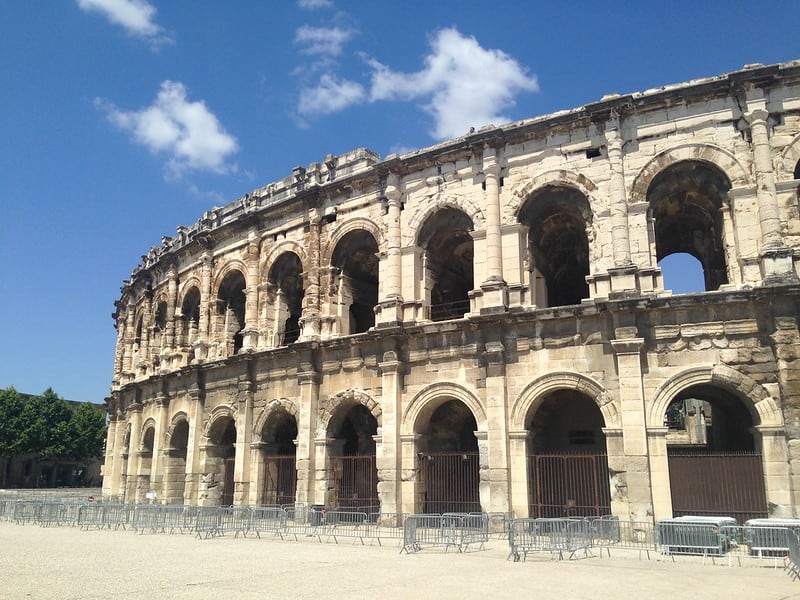If you’re looking for a cultural city break, consider a trip to Nîmes, a UNESCO World Heritage Site in southern France. This Roman-era outpost was home to numerous well-preserved monuments. The Arena of Nîmes, a double-tiered amphitheater, is still used for concerts and bullfights today. Other Roman attractions include the Pont du Gard tri-level aqueduct, Maison Carrée temple, and Jardins de la Fontaine.
Arenes de Nimes
If you’ve never been to France, you’ve probably never heard of the ancient amphitheatre called the Arenes de Nîmes. The structure was built around 70 CE, just a few years after the Colosseum in Rome. Today, the arena is one of the best-preserved Roman amphitheatres in the world. The arena itself is 133 meters long and 68 meters by 38 metres.
This ancient amphitheatre is one of the largest in Europe, with a capacity of 24000 spectators. Today, the amphitheatre is a popular location for local and international events. Music festivals and film festivals are frequently held in this spectacular venue, which regularly attracts international stars. However, in recent years, a restoration program has begun to focus on the amphitheater’s architectural features. In fact, the project is expected to take years to complete.
The Nimes Arena is home to numerous exhibits and an audio guide, which helps explain all aspects of the building. The audio guide, available in 8 languages, covers nearly everything about the arena’s history. The Arenes de Nimes Arena is easy to find – parking Indigo Nimes Arenes is adjacent to the arena. The town’s train station and bus and coach stations are also within walking distance. You’ll find more than enough parking to get around the city.
Jardins de la Fontaine
The Gardens de la Fontaine were designed by Jacques-Philippe Mareschal, a military engineer under the rule of King Louis XV in the 18th century. The gardens were constructed on an ancient spring, and baths built by the Roman Emperor Augustus were discovered on the site. The Gauls discovered this spring before the Romans. They named the town after the god of springs, Nemausus.
The Jardins de la Fontaine are the first public gardens in Europe. The garden was built in 1745 and was opened shortly after the discovery of a theatre and temple dedicated to Augustus. Today, the gardens are popular with tourists and locals alike. Here, visitors can experience the splendor of ancient Nimes and take in a beautiful view of the city. Here, you can also get a glimpse of the crumbling Temple de Diane.
The Jardins de la Fontaine are open Tuesday through Sunday. The museum is closed Mondays. Nimes has many accommodations, from luxury hotels to resort settings. Jardins Secrets hotel, set in landscaped Mediterranean gardens, is an excellent choice. It’s located a ten-minute walk from Arenes. The luxurious rooms and suites have traditional décor, Empire-style salons, and comfortable sofas.
Les Halles
The covered markets in Nimes showcase the city’s produce. The area is filled with stalls offering fruits, vegetables, meat, fish, and bread. Aside from shopping, the halls also offer restaurants and nightlife. The ruins and covered markets can be enjoyed for free and are located nearby the covered market. Here, you can take a break from exploring the city to sample the local cuisine. And, once you’ve finished shopping, you can head out for some wine, cheese, and snacks.
The original covered market, which was built in the 19th century, is now a multi-storey car park. The old hall was destroyed and rebuilt, but the new interior is missing the elegant and chic atmosphere of open-air markets. Parking is limited in Nimes, so make sure to plan your trip accordingly. Alternatively, you can visit the market on Sunday, when hours are extended to accommodate a special event.
Musée de la Romanité
When you are looking for things to do in Nîmes, you’ll likely be drawn to the archeological museum, Musée de la Romanité. The newest addition to the city’s arts and culture scene opened June 2 this year, so you can take in a new exhibition right away. And while you’re there, you’ll also have the chance to explore the newly renovated city’s historic district, which is also known for its beautiful architecture.
If you’re looking for a more religious experience, the Church of St. Perpetua is a must-see. Originally a Roman temple, it has an eclectic blend of classical and modern architecture. The building also contains an impressive 17th-century organ and is situated on the site of Augustus’ Roman temple. Whether you’re looking for things to do in Nimes or just looking for a relaxing atmosphere, this city has something for everyone.
The gardens are also worth a visit. Nimes has many ancient monuments, including the Temple of Diana. Visitors can enjoy the peaceful atmosphere of the garden, while exploring its history. You’ll find fountains and winding paths throughout the gardens. You can also take a break at a cafe or a restaurant. Nearby attractions include the Carre d’Art, Square Antonin, and the Bouquerie.
La Maison Carrée
One of the oldest and most beautiful monuments in Nimes is the Roman Temple of La Maison Carree, which rises nine stories above the historic center. The temple is an excellent example of Vitruvian architecture, and one of the best preserved Roman temples in the world. This building has also been a church and a mediaeval town hall, and during the Revolution it served as an official building. Today, it is a multimedia museum, and the most spectacular part is under scaffolding.
The ancient Roman public games are re-enacted in Nimes. The event is known as Les Grands Jeux Romains, and takes place in April or May. You can also attend Musique au Cloitre, which hosts classical music concerts in Nimes’ elegant 18th-century Cloitre des Jesuites. There are also outdoor markets, antique shops, and Flamenco and jazz concerts.
Tour Magne
If you’ve ever been to Nimes, France, you’ve probably noticed the ancient Roman watchtower, La Tour Magne. Standing tall on the Mont Cavalier, it is the only piece of the town’s Roman era structure that still exists. Augustus built the tower here, and it has been marked as a monument since 18402.
Its name is derived from the fact that it was built to overlook the oppidum, a temple located atop the Tour Magne. The building was a symbol of the city’s wealth, and it has a long history as a Roman monument. The XIIe century was the first time it was constructed, though it was originally built much earlier. Throughout the centuries, Nimes was an important city and the city’s Tour Magne continues to serve its purpose today.
The tower is the city’s most famous landmark and is the only remaining tower of Nimes’ ancient Augustan fortifications. The tower is situated on Mont Cavalier, and its vantage point allows for both unobstructed and tactical views of the town. The tower is 32.5 meters tall and was constructed to express the power of the city and serve as a signal and watchtower. During the Hundred Years War, the tower served as the main stronghold.
Temple de Diane
The Interior of the Temple de Diane in Nimes is a stunning painting by French artist Romain Jouve. The work depicts the temple and the gardens of the Fountain in Nimes. It’s nicely framed and is under glass. The painting is signed and dated 1783. The temple was originally built during the reign of Augustus and is a prime example of Roman architecture. In this painting, the artist emphasizes the monumentality and details of the Temple. The painting includes several small details that show the damage caused by the French Wars of Religion.
One of the most interesting features of the Temple de Diane is the opus sectile floor, which is made up of precious marble shapes backed by mortar. This floor can be accessed from the Jardins de la Fontaine. Nimes is located on the south-eastern coast of France and is 55km from Montpellier and 120km from Marseille. The site is well worth a visit. You can also explore Nimes’s medieval quarter and admire its many buildings.
Cathedrale Notre-Dame-Et-Saint-Castor de Nimes
A trip to Nîmes would not be complete without visiting the nearby Cathedrale Notre-Dame-Et-St-Castor de Nimes. Dedicated to the Blessed Virgin Mary, this Roman Catholic church is also the local devotion of Saint Castor of Apt. While visiting the Nîmes Cathedral, make sure to take time to admire the beautiful artworks inside.
The Cathedrale Notre-Dame-Et-St-Castor de Nimes is a great place to take a break and see a little of the town. The cathedral was originally built in Romanesque style but was largely destroyed during the wars of religion. It was rebuilt entirely in the 19th century, retaining many features of the original Romanesque building. The cathedral has a beautiful Old Testament frieze and an impressive chapel for praying the Rosary. The building also has historic monument status, which is a benefit for its preservation.
Besides visiting the Cathedral, visitors can also take time to see the Amphitheater and Maison Carree, an ancient Roman temple. These monuments are the pride of the citizens of Nimes and host events throughout the year. Once you have had enough of the historic sites, you can move on to the Arena de Nimes, a Roman amphitheatre that sits 390 metres south of the Cathedral.

